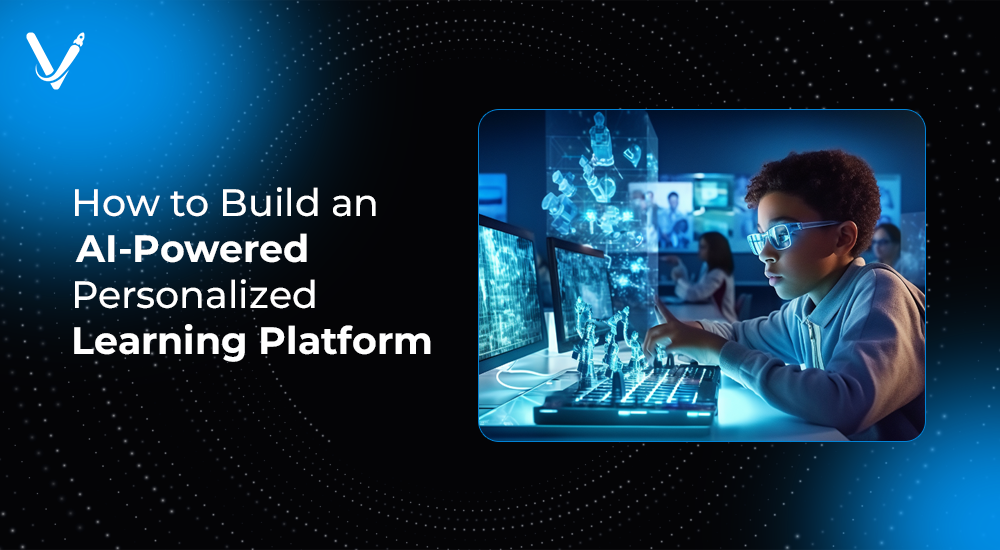How to Build an AI Powered Personalized Learning Platform


- Apr 16, 2025
In the digital age, education is undergoing a radical transformation. Traditional one-size-fits-all teaching methods are giving way to more dynamic and adaptable approaches. Among these innovations, Artificial Intelligence (AI) stands out as a revolutionary force, enabling the creation of personalized learning platforms tailored to individual students' needs, preferences, and pace.
Personalized learning platforms leverage AI to provide customized educational experiences that enhance engagement, boost learning outcomes, and foster a lifelong love of learning. In this article, we will guide you through the process of building an AI-powered personalized learning platform, from understanding core concepts to deployment and maintenance.
An AI-powered personalized learning platform leverages artificial intelligence and data analytics to create custom learning experiences for individual students. Rather than offering the same content to every learner, it adapts the material, pace, and delivery method based on the learner's behavior, performance, and preferences.
Unlike traditional platforms, these systems continuously learn and improve, analyzing data such as:
Popular platforms like Duolingo, Khan Academy, and Coursera already use AI-driven techniques to personalize education for millions.
Adaptive Learning Paths
AI can map out a unique learning journey for each student, adjusting based on their strengths and weaknesses.
Real-Time Feedback
Instant feedback helps learners understand where they’re going wrong and how to improve—boosting confidence and motivation.
Improved Engagement
When learners interact with content that matches their style and pace, they stay more engaged and retain more information.
Efficient Content Delivery
AI curates and delivers relevant content without overwhelming the learner, making the most of their study time.
User Profile & Data Collection: Tracks learner behaviors, progress, goals, and preferences.
Content Management System (CMS): Houses and organizes all learning materials—quizzes, videos, readings, etc.
AI Algorithms: Analyze data to drive personalization, recommendations, and assessments.
Recommendation Engine: Suggests the next best lesson, topic, or activity based on user behavior.
Analytics Dashboard: Gives learners and educators insights into performance, engagement, and progression.
UI/UX Interface: A clean, intuitive design ensures easy navigation and user satisfaction.
Creating an AI powered learning platform may sound complex, but breaking it down into manageable steps makes the process far more approachable. Here's a detailed guide to help you build a platform that’s intelligent, impactful, and user-centric.
Before writing a single line of code, start by getting clear on who you’re building for and what you want them to achieve. Ask yourself:
Understanding your audience allows you to shape everything—from your content strategy and user interface to the AI models you’ll use for personalization. For instance, school-age users may benefit from gamified learning and visual feedback, while professionals may prefer structured, goal-oriented modules with clear milestones.
Once your audience is defined, map out the learning framework your platform will follow. This structure will guide how learners interact with the system and progress through content. Some popular models include:
This is also where you determine how assessments will work, how content is organized (by modules, topics, or difficulty levels), and how learners receive feedback. An effective architecture ensures a coherent and engaging user journey.
The technology stack is the backbone of your platform. It’s crucial to pick tools that support not just development, but scalability, security, and real-time data processing. Here's what to consider:
If you're aiming to include voice, natural language, or image-based interaction, consider integrating APIs like Google Dialogflow, IBM Watson, or OpenAI for NLP capabilities.
This is the heart of your platform—where artificial intelligence transforms static content into personalized, engaging learning experiences. Here are the top features you can integrate:
Content Personalization
Using machine learning algorithms, your platform can track user behavior and suggest content based on their interests, past activity, and performance. For example, if a student struggles with algebra but excels in geometry, the system can adjust the focus accordingly.
Adaptive Assessments
AI can dynamically adjust quiz difficulty in real time based on how a learner is performing. This ensures assessments are neither too easy nor too hard, keeping learners in a productive zone.
Predictive Analytics
Analyze user data to forecast behaviors like potential dropouts or lack of engagement. Early warnings allow educators or the system itself to intervene with encouragement, content recommendations, or support.
Conversational AI (Chatbots)
AI chatbots can guide learners, answer common questions, suggest resources, and even provide study tips—offering 24/7 support without human intervention.
Progress Tracking & Feedback Loops
AI can automatically generate performance reports, highlight strengths and weaknesses, and suggest next steps for continuous improvement.
When handling educational data—especially for minors—privacy and security must be non-negotiable. Build your platform with strong security protocols and ensure compliance with:
Encrypt personal data, secure API endpoints, and ensure role-based access to sensitive information. Be transparent about data usage and allow users to manage their privacy settings.
Before your platform goes live, it’s crucial to run extensive testing to ensure everything works as intended. Here's how to approach it:
This step-by-step process provides a strong foundation to build a powerful, user-friendly, and AI-enhanced learning experience. The key is to focus on learner value—let AI do the heavy lifting behind the scenes while you focus on delivering meaningful, impactful education.
While building an AI-powered personalized learning platform offers incredible potential, it's not without its hurdles. These challenges can impact development timelines, user adoption, and long-term scalability.
However, with a thoughtful strategy and the right team, each challenge can be turned into an opportunity for innovation and growth.
The Problem:
AI systems thrive on data—but more isn’t always better. When a learning platform starts collecting user activity, content interactions, assessment scores, and engagement metrics, it quickly generates massive volumes of data. Without proper filtering and analysis, this can become overwhelming and even misleading.
How to Overcome It:
Focus on collecting relevant, structured, and clean data. Define the most valuable metrics upfront (like learning time, content completion, or quiz accuracy), and build your AI models around those. Use automated tools for data cleaning and validation.
The Problem:
Even the most advanced AI can’t compensate for poor content. If the learning materials are outdated, inconsistent, or not aligned with educational goals, learners won’t benefit—no matter how personalized the experience.
How to Overcome It:
Collaborate closely with subject matter experts (SMEs), educators, and instructional designers during the content creation phase. Implement content review workflows and feedback loops so that outdated or underperforming lessons can be flagged and updated.
The Problem:
AI is great at scaling and automating tasks, but it can sometimes feel impersonal—especially in education, where mentorship and human interaction often play a key role in learner success.
How to Overcome It:
Strike a healthy balance between AI automation and human involvement. For example:
Remember: AI should enhance human-led learning, not replace it.
By anticipating these challenges and addressing them head-on, you can build a personalized Ai learning platform that’s not only powerful but also trusted, inclusive, and sustainable. Remember, the goal is to create an environment where every learner feels supported—and where technology enhances, rather than complicates, the journey.
As AI technology continues to evolve, the future of personalized learning is poised to become even more immersive, intelligent, and intuitive. One emerging trend is the integration of Augmented Reality (AR) and Virtual Reality (VR), allowing learners to explore 3D environments and interact with simulations—perfect for subjects like science, history, or technical training.
Another game-changer is Emotion AI, which analyzes facial expressions or vocal cues to detect frustration, confusion, or excitement, enabling platforms to adapt in real time based on emotional feedback.
Additionally, voice-enabled learning assistants are making education more accessible, particularly for younger learners and those with disabilities. We’re also seeing increased interest in blockchain-based credentialing, ensuring secure and verifiable digital certificates for learners.
As these technologies mature, AI-based learning platforms will continue to redefine how, where, and what we learn—making education not just smarter, but truly learner-centered.
AI is reshaping education by enabling platforms that learn about the learner. Building a personalized AI learning platform involves not only technical expertise but also a deep understanding of pedagogy, ethics, and user experience.
With the right approach, tools, and commitment to quality, developers and educators can create AI-driven platforms that empower learners, personalize pathways, and democratize access to education for all.
If you're ready to take your idea from concept to reality, partnering with the right development team is key. At Vasundhara Infotech, we specialize in creating custom, AI-driven learning platforms that empower educators and engage learners.
Whether you’re an edtech startup or an established institution, our expert team can help you design, develop, and scale your personalized learning solution. Get in touch with our experts.
Copyright © 2026 Vasundhara Infotech. All Rights Reserved.
